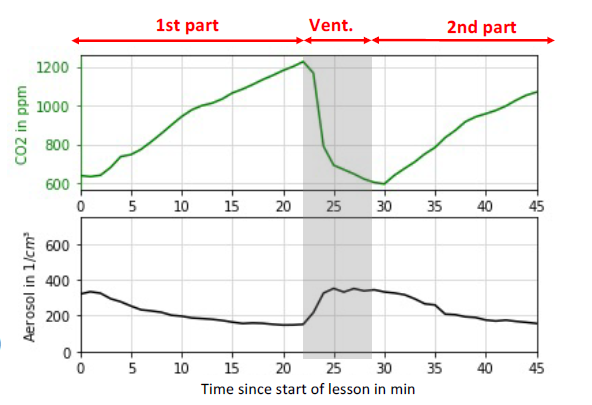Schools open again. Against the normalized COVID-19 prevention and control measures as a background, schools at home and abroad are heading towards creating a safer learning environment for students. Therefore, classroom air quality is an important topic. Recently, the German Federal Environment Agency recommended that schools and educational institutions should conduct an air quality assessment in their teaching areas to determine whether they need to purchase air purifiers or not. Palas® provides solutions for this: with PAG 1000 portable aerosol generator, and AQ Guard ambient air quality monitor, indoor aerosol concentration can be simulated and precisely measured to help make the decisions and keep students in safety.
Open windows for ventilation or to use air purifiers?
The air quality of classrooms, where children come together in a limited space, cannot be overlooked. Indoor air quality is determined by the concentration of carbon dioxide and aerosols, both of which will rise over time. Excessive concentration of carbon dioxide will make students feel sleepy and less focused. Aerosol distribution, on the other hand, is even more critical: when students breathe or talk, there will be aerosol droplets in the air which they exhale. Once there is an infected student, bacteria or virus will quickly spread through droplet inhalation.

At present, there are two main methods used to improve the air quality of classrooms: one is to open windows for ventilation, introducing fresh air to dilute the exhaled aerosol. The other is to use an air purifier to reduce the level of particulate matter. Which method is more effective? Palas® conducted campus fielded measurements of its PAG 1000 and AQ Guard and came up with interesting findings.

Field measurements and Conclusion
The Palas® PAG 1000 used in the test can simulate different indoor aerosol concentrations by generating test aerosols. The combination of AQ Guard and PAG 1000 can monitor the change of indoor aerosol concentrations within a certain period of time.

The two instruments are placed in a classroom, with the air purifiers turned on, and the windows are opened every 20 minutes for about 6-minute ventilation. Under the monitoring of AQ Guard, it can be seen that in a 40-minute class, the concentration of carbon dioxide is significantly affected by ventilation, especially in the first few minutes. And the aerosol concentration is continuously reduced by air purifiers during the class but increases with the influx of fresh air during ventilation. Experimental results show that both methods help to improve indoor air quality.

Further studies have shown that once ventilation ceases, aerosol will soon fill indoor air again. Moreover, short phases of good air quality alternate with long phases of poor air quality with intermittent ventilation. The risk of infection is hardly reduced. As a result, it is more recommended to reducing the risk of infection in the classroom by opening windows during breaks or when classrooms are vacant. This also helps to avoid bringing potentially infectious air into the next class. On the other hand, air purifiers could lower the risk of infection by up to 65%. It is especially suitable for those teaching areas that cannot be effectively ventilated due to architectural structures. Nonetheless, attention must be paid to operating noise. Silent or low-noise air purifiers are more recommended.

Palas® Technical Principles
Palas® PAG 1000 portable aerosol generator can simulate real scenarios, produce harmless test aerosols to simulate aerosols emitted by human, and distribute them in the room. The average size of the particles produced by the aerosol generator should be in the range of 0.2-0.3 µm to simulate aerosol particles exhaled by people and avoid a decrease in concentration due to sedimentation. Once the target concentration reaches, AQ Guard will measure the aerosol concentration. AQ Guard can measure aerosols and carbon dioxide concentrations simultaneously, detect the risk of infection and evaluate indoor air quality.
PAG 1000 Portable Aerosol Generator

Advantages:
· Small, portable
· Easiest handling
· Fast responding qualities
· Internal pump for autonomous operation
Particle size distribution and concentration
· Wide setting range by high-/low-switching
· Highest stability even for very low concentrations
· Best reproducibility
· 6 h of operating time in battery mode
· Robust, long-living, low-maintenance
· Cost-effective
Applications:
· Test of Laminar-Flow-Boxes
· Clean room acceptance test
· Recovery test
· Smoke detector test
· HEPA/ ULPA filter testing
· Laboratory applications
· Flexible aerosol supplies on side
AQ Guard Ambient Air Quality Monitor


Adavantages:
· Technology based on the type-approved Fidas® 200 series (EN16450 and MCERTS)
· Simultaneous measurement of Cn, PM1, PM2.5, PM4, PM10, TSP, CN, etc.
· High accuracy with advanced algorithms
· Long term stability thanks to self-calibration for measurement of flow rate, particle size channels, and gaseous pollutants
· Operates on AC, DC, or power-over-Ethernet
Applications:
· Industry: Production processes, bulk material handling (mixing, discharge, storage, packaging, etc.), fenceline monitoring
· Construction sites: Roads, railroads, demolition sites
· Buildings: Schools, kindergartens, hospitals, hotels, offices, public service buildings
· Residential buildings near construction sites or other polluted areas
· Public transportation: Airports, train stations, tramway & underground stations, cruise ships, passenger cabins such as in tram and train
Palas® China will arrange a series of online webinars both in English and Chinese for Ambient air quality continuous monitoring system, Palas SMPS scanning mobility particle sizer, Palas Promo & Aerosol Generator & Dilution system, ISO 16890 filter media tester, Palas MFP 3000 G, ISO 29463-3 filter media tester, Palas MFP Nano plus 4000, ISO 17536 Fractional filtration efficiency tester of Oil Mist Separator, Palas HMT 1000, as well as Particle Distribution Measurement Devices Introduction – Optical Scattering Method and many other solutions. If interested in the webinars for our products, you are more than welcome to register on our official website and get the latest webinar plan!
Register online now to participate in our webinars if interested


